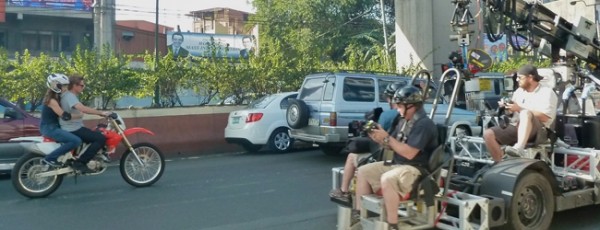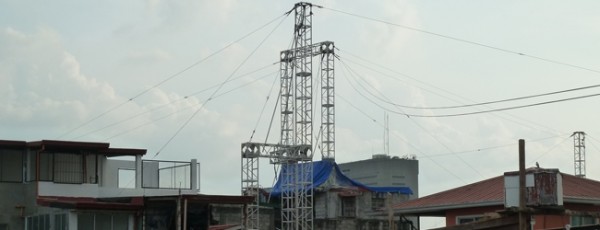Spy game: Filming on location in Manila for The Bourne Legacy
The Bourne Legacy is the latest in the action spy franchise that already has a history of putting eye-catching locales front and centre. This time Manila is a centrepiece location and TLG spoke to Location Manager Dow Griffith about the challenges of filming the Philippine capital.
 Manila may have the world’s highest population density, but it offered the look that filmmaker Tony Gilroy was seeking when he scouted South-East Asia in pre-production for the film. Unlike in Vietnam - which was also considered - the Government didn’t demand script approval before authorising the shoot. In a modern world where online script leaks are increasingly commonplace, this was a deal breaker that edged Saigon out of contention.
Manila may have the world’s highest population density, but it offered the look that filmmaker Tony Gilroy was seeking when he scouted South-East Asia in pre-production for the film. Unlike in Vietnam - which was also considered - the Government didn’t demand script approval before authorising the shoot. In a modern world where online script leaks are increasingly commonplace, this was a deal breaker that edged Saigon out of contention.
Griffith notes: “With a Bourne movie you pretty much know the type of film which will be generated, but we were not willing to reveal Tony Gilroy’s script. Vietnam basically said ‘No script approval, no filming’.
They helped us accomplish complicated set-ups with cable camera rigs running over and through rooftops, high-speed chases down eight-lane roadways and presidential corridors, no less.
Dow Griffith, Location Manager
“In the Philippines citizens were very co-operative while we filmed Bourne Legacy and that became a big advantage. They helped us accomplish complicated set-ups with cable camera rigs running over and through rooftops, high-speed chases down eight-lane roadways and presidential corridors, no less.
“We replaced 150 single family home rooftops in the congested community of San Andres, moving some families out completely. Everyone was very co-operative.”

As with any large-scale action film, shooting in the streets proved a challenge. A climactic motorcycle chase was filmed through a fish market in Navotas on Manila Bay (pictured above during business hours), but changes were needed to make it a suitable filming location. The kilometre-long shed needed alterations to the roof to let in more light and the floor was a hazard for the motorcycle (pictured below after a planned stunt).

Griffith recalls: “The smooth concrete floor of the structure was soaked with fish oil, fish scales and blood each night while millions of dollars of fish were bought and sold. The shed floor had the traction of an ice-skating rink. You could barely walk safely; great place to set a motorcycle chase, no?”
One tool that made things easier for tracking the high-speed action was the so-called Go-Mobile, a type of camera car that’s been redesigned and improved over the years by renowned stunt unit director Dan Bradley. It’s rigged with extensive camera configurations but the sheer amount of equipment it carries can make it nearly 20 feet high.
The shed floor had the traction of an ice-skating rink. You could barely walk safely; great place to set a motorcycle chase, no?
Dow Griffith, Location Manager
Griffith explains: “At that height alternate access routes need to be found and you get busy trimming trees, adding a chainsaw to your location kit! Wires need to be removed and nobody knows how to grow a collection of electrical and utility wires in the streets like Metro Manila. We spent weeks moving and removing wires all over the city, not just for vehicle clearance but just to be able to film our scenes.”

Entire neighbourhoods were affected by preparation for some of the chase stunt work, as riggers built cable towers that were four stories high (see set up above and in action below) and contained intricate computerised motors. These took months to set up and arrangements were made to move locals out of their apartments temporarily as the towers were built through their roofs.

Direct presidential approval was needed to film a major car chase on Ramon Magsaysay Boulevard. As though daily traffic congestion wasn’t enough of a challenge, Ramon cuts through the heart of the city and is used on a daily basis by the President and his ministers to get to their offices. Griffiths adds: “This would seem an unlikely place to stage elaborate, high-speed car chases, right? Not if you are a big-budget Hollywood movie. The bigger the budget, the bigger the mess you can contemplate!”
Lope ‘Jun’ Juban, Jr, the production’s Philippine producer with servicing company Philippine Film Studios, was able to arrange several weekends of filming on Ramon Magsaysay, but there was constant uncertainty that the filming permit was going to be revoked. Apparently the authorities hadn’t realised just how much of an impact a large-scale action movie makes on location.
This would seem an unlikely place to stage elaborate, high-speed car chases, right? Not if you are a big-budget Hollywood movie. The bigger the budget, the bigger the mess you can contemplate!
Dow Griffith, Location Manager
Griffith says: “Each weekend we strung up three kilometres of ‘invisible’ wire fence to keep the pedestrians at a safe distance from skidding and crashing vehicles … Pot holes needed to be filled, businesses shut down, bus traffic re-routed, emergency vehicles notified, public notifications published in the local newspapers and announced on radio and TV.
 “This is not the kind of operation where you want to hear ‘Oh, by the way, we might not allow filming tomorrow’!”
“This is not the kind of operation where you want to hear ‘Oh, by the way, we might not allow filming tomorrow’!”
Events in fact did turn against them and permission was revoked before the full sequence was finished - something that's never happened to Griffiths before - although there were conflicting messages from different levels of the Government. Griffith adds: “A Government should not accept to host a movie that takes place on the streets under the condition that you can’t inconvenience traffic flow. That is just not realistic and it’s not what we understood during those important meetings in pre-production.”
Glitches aside, Griffith describes the Manila shoot as a positive experience. English is widely spoken, which clearly makes things easier for US productions, and Griffith praises the work of Jun Juban and his team.
He also believes that Manila has a real future as a filming location with global appeal: “They have been in that position before. There has been more than a decade lull in foreign feature films selecting the Philippines as a desirable location, but there is no reason to assume that will continue.”
The Bourne Legacy is in the midst of a global cinema release.
Stills images courtesy of Dow Griffith.
Related Posts
- From DePalma to Spielberg: Filming with Location Manager Dow Griffith
- TLG scouts Iceland with Dark Knight Rises and Bourne Location Managers
- Bourne Legacy finds armed civilians and great hotel service on location in Manila
- Philippines politician pushes for formal filming incentive to boost tourism
- Will Smith films sci-fi epic After Earth on location in US and Central America
- Location Scouting in Poland: Palaces, Underground Labyrinths and the best cheat for Berlin
- TLG prepares for Iceland scout with Dark Knight Rises and Bourne Location Managers
- Vin Diesel to film sequel to action movie xXx on location in Philippines
Related posts:
Comments
Not Logged in
You must be logged in to post a comment
There are 3 comments
Ravi Dube
| #
Dow Griffith, one of the best. I am privileged to have worked along side Dow in Manila and a few years ago on Bourne Supremacy in Goa. One of the most interesting guys that I have met in the film business.
Reply
Ravi Dube
| #
A terrific team at Phillippine Film Studios Inc. under Jun Juban who made our work so easy on Bourne Legacy. I hope that this latest Bourne kickstarts a resurgence in the Phillippines as a popular film location choice. The variety of scenery in the islands is astounding and enthusiasm from the local population refreshing.
Reply
kitkat macaraig
| #
I was able to witness part of the filming of this from my condo in Pasig.
Reply